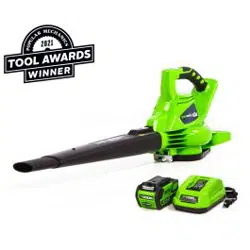Loading ...
Loading ...

4 5
GENERAL SAFETY RULES
GENERAL SAFETY RULES
• Keep all parts of your body away from any moving parts and all hot surfaces of the unit.
• Do not put any object into openings. Do not use with any opening blocked; keep openings free
of dust, lint, hair, and anything that may reduce air ow.
• Check the work area before each use. Remove all objects such as rocks, broken glass, nails,
wire, or string which can be thrown or become entangled in the machine.
• Use only identical manufacturer’s replacement parts and accessories. Use of any other parts
may create a hazard or cause product damage.
• Do not charge battery tool in rain, or damp or wet location. Following this rule will reduce the
risk of electric shock.
• For household use only.
• Battery tools do not have to be plugged into an electrical outlet; therefore, they are always in
operating condition. Be aware of possible hazards when not using your battery tool or when
changing accessories. Following this rule will reduce the risk of electric shock, re, or serious
personal injury.
• Remove or disconnect battery before servicing, cleaning or removing material from the
gardening appliance.
• Use only Greenworks batteries (Model #29472.)
• Store idle appliances - When not in use, blower should be stored indoors in a dry, locked
place out of the reach of children.
• Do not dispose of the batteries in a re. The cell may explode. Check with local codes for
possible special disposal instructions.
• Do not open or mutilate the batteries. Released electrolyte is corrosive and may cause
damage to the eyes or skin. It may be toxic if swallowed.
• Do not place battery tools or their batteries near re or heat. This will reduce the risk of
explosion and possibly injury.
• Batteries can explode in the presence of a source of ignition, such as a pilot light. To reduce
the risk of serious personal injury, never use any cordless product in the presence of open
ame. An exploded battery can propel debris and chemicals. If exposed, ush with water
immediately.
• Do not crush, drop or damage battery pack. Do not use a battery pack or charger that has
been dropped or received a sharp blow. A damaged battery is subject to explosion. Properly
dispose of a dropped or damaged battery immediately.
• Exercise care in handling batteries in order not to short the battery with conducting materials
such as rings, bracelets, and keys. The battery or conductor may overheat and cause burns.
Do not open or mutilate the batteries. Released electrolyte is corrosive and may cause
damage to the eyes or skin. It may be toxic if swallowed.
• For best results, your battery tool should be charged in a location where the temperature is
more than 50°F but less than 100°F. To reduce the risk of serious personal injury, do not store
outside or in vehicles.
• Under extreme usage or temperature conditions, battery leakage may occur. If liquid comes in
contact with your skin, wash immediately with soap and water, then neutralize with lemon juice
or vinegar. If liquid gets into your eyes, ush them with clean water for at least 10 minutes,
then seek immediate medical attention. Following this rule will reduce the risk of serious
personal injury.
• Do not point the blower nozzle in the direction of people or pets.
• Never run the unit without the proper equipment attached. Always ensure the sweeper tubes
are installed.
• When not in use, blower should be stored indoors in a dry, locked up place—out of the reach
of children.
• Maintain tool with care. Keep fan area clean for best and safest performance. Follow
instructions for proper maintenance. Do not attempt to clear clogs from tool without rst
removing the battery.
• To reduce the risk of electrical shock, do not expose to rain, do not use on wet surfaces. Store
indoors.
• Save these instructions. Refer to them frequently and use them to instruct others who may
use this power tool. If you loan someone this power tool, loan them these instructions also.
W A R N I N G (PROPOSITION 65)
Some dust created by power sanding, sawing, grinding, drilling, and other construction activities
contains chemicals known to cause cancer, birth defects or other reproductive harm. Some
examples of these chemicals are:
• Lead from lead-based paints
• Crystalline silica from bricks and cement and other masonry products, and
• Arsenic and chromium from chemically treated lumber.
Your risk of exposure to these chemicals varies depending on how often you do this type of
work. To reduce your exposure to these chemicals, work in a well-ventilated area, and work with
approved safety equipment, such as dust masks that are specially designed to lter out microscopic
particles.
CHILD SAFETY
Tragic accidents can occur if the operator is not aware of the presence of children.
• Keep children out of the working area and under the watchful care of a responsible adult.
• Do not allow children under the age of 14 to operate this blower. Children who are 14
years of age and older must read and understand the operating instructions and safety
rules in this manual and must be trained and supervised by a parent.
• Stay alert, and turn the blower off if a child or any other person enters the working area.
• Use extreme care when approaching blind corners, doorways, shrubs, trees, or other
objects that may obscure your view of a child who may run into the path of the blower.
Loading ...
Loading ...
Loading ...
